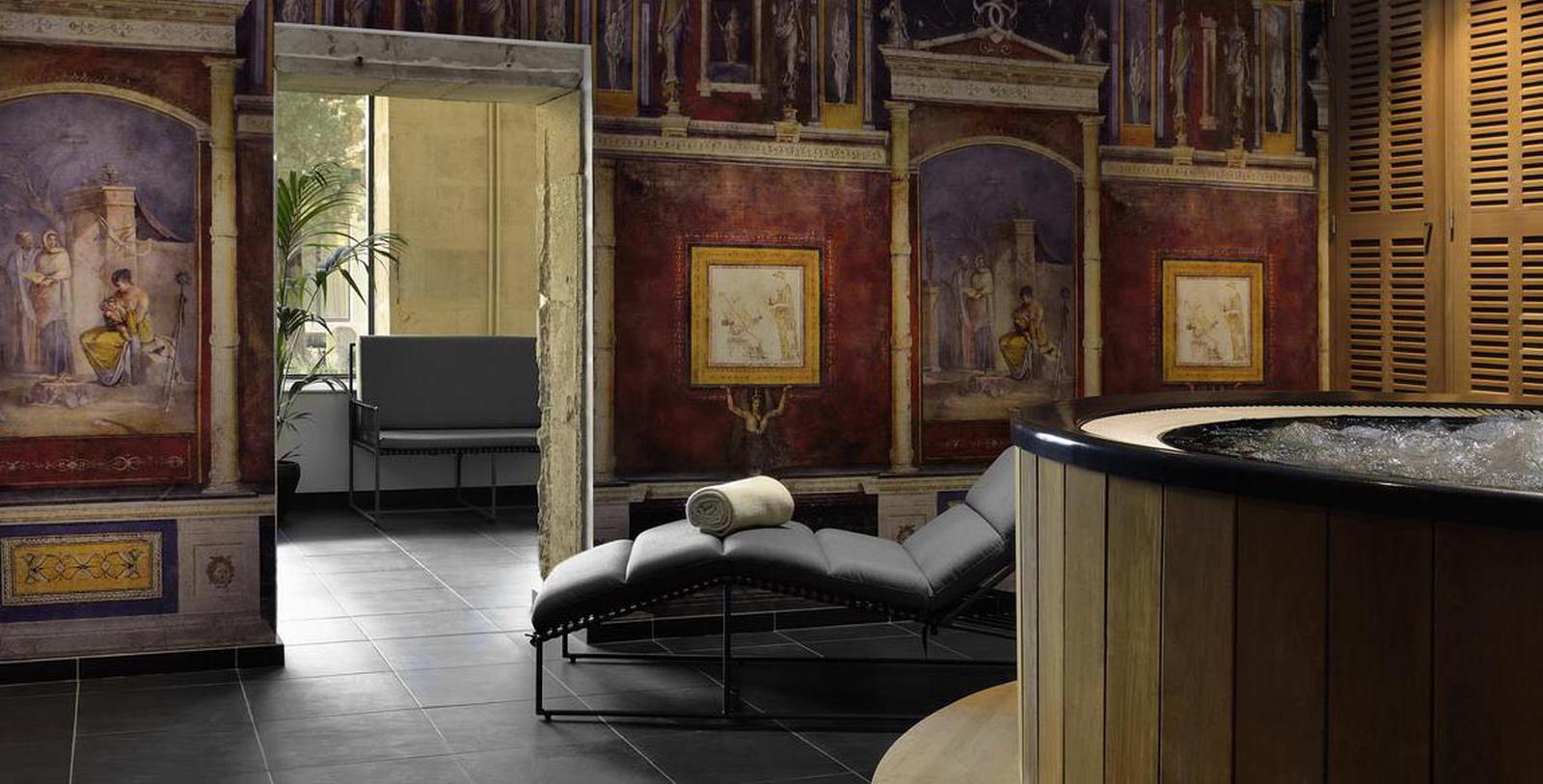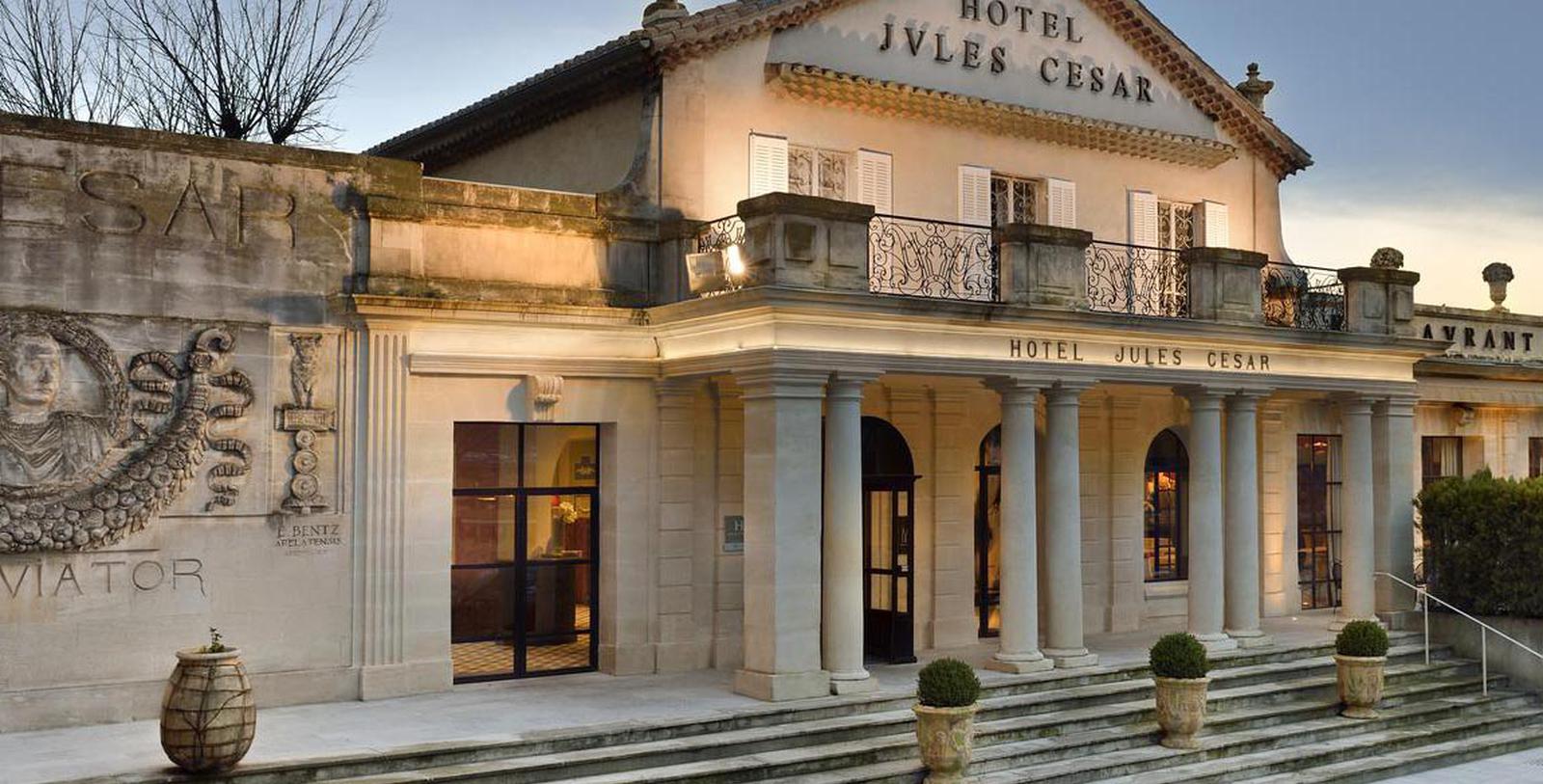Receive for Free - Discover & Explore eNewsletter monthly with advance notice of special offers, packages, and insider savings from 10% - 30% off Best Available Rates at selected hotels.
history
Discover the Hôtel & Spa Jules César Arles – MGallery by Sofitel, which was once a Carmelite nunnery founded during the 17th century.
Hôtel & Spa Jules César Arles – MGallery by Sofitel, a member of Historic Hotels Worldwide since 2018, dates back to 1661.
VIEW TIMELINEThrongs of immigrants arrived in Arles in the 17th century, making it one of France’s busiest points of entry at the time. Among the city’s new transplants were an order of Carmelite nuns, who were in need of a new place to worship. The sisters purchased a plot of land upon which to construct a convent, as well as an accompanying chapel. By 1634, the construction on the Carmelite complex was complete. A series of notable figures from Arles approached the nuns less than a decade later, inquiring as to whether they could add a public house for the city’s poor. The nunnery assumed the project as its own personal mission for the next twenty years, working closely with its local benefactors to raise the appropriate funds for the building’s creation. But the nuns had fallen short of their fiscal goals by the beginning of the 1660s. Fortunately, salvation came in the form of Archbishop François de Grignan. On the sisters’ behalf, he successfully galvanized support throughout the city to help finish the building’s development. Completed in 1661, the shelter debuted before the public as the “Hospice of Charity.” The Hospice of Charity became a home for the poor and employed many of the homeless, as begging was illegal.
The small Carmelite order lived cloistered within the complex over the next two centuries. But their time at the nunnery came to an end with the onset of the French Revolution. The National Assembly of France suppressed many monastic orders during the uprising. Among its many targets included the Carmelite complex in Arles. In 1791, the National Assembly confiscated the sisters’ nunnery, leaving only its public house alone. Eventually, the Hospice of Charity relocated its operations into the former convent, having felt that its own facilities had become too derelict. The Hospice of Charity continued to occupy the site until 1928, when several entrepreneurs transformed the erstwhile convent into a luxury hotel. The location quickly developed a reputation as a world-class holiday retreat. Intellectuals from across the globe soon visited the hotel regularly, such as Ernest Hemingway and Pablo Picasso. Even members of the British Royal Family resided at the building for considerable periods of time. King George VI in particular was known to patronize the hotel!
By the beginning of the 21st century, time had clearly taken its toll on the building. Sofitel had come to acquire the location by the 2010s, deciding that the historic building was in desperate need of a thorough renovation. Celebrated fashion designer Christian Lacroix led the makeover and brilliantly combined elements of the location’s stunning 17th-century character with contemporary artistic flair. Reopening in 2014, the ancient convent debuted as the magnificent “Hôtel & Spa Jules César Arles – MGallery by Sofitel.” Sofitel has been incredibly pleased with the hotel since its fabulous rebirth. The Hôtel & Spa Jules César Arles continues to serve as one the leading travel destinations along the Gulf of Lion. As Lacroix said himself, “People who stay at the hotel are not only looking for a second home; they are looking for one that tells a story.” And since 2018, the Hôtel & Spa Jules César Arles is a proud member of Historic Hotels Worldwide, too.
-
About the Location +
Founded millennia ago, Arles has a remarkable history that few other cities in the world can match. The Ligurians first inhabited the region in the 8th century BC, who recognized its significance due to its proximity to both the Rhône and the Mediterranean Sea. Phoenician traders later relocated to the area, establishing Arles as one of Europe’s busiest harbors. But the city truly did not become prosperous until the Romans seized it in 123 BC. The Legio VI Ferrata had specifically relocated to the community and established its headquarters within the center of town. The support of the legion would prove crucial to Julius Caesar’s military coup, offering the statesmen manpower and material in his war against Pompey. When the conflict finally concluded as a victory for Caesar—now ruling Rome as a dictator—he formally established Arles as a colony for the veterans that had served in the legion. (Its full title was “Colonia Iulia Paterna Arelatensium Sextanorum,” or “The ancestral Julian colony of Arles of the soldiers of the Sixth.”) Caesar’s triumph also elevated Arles as the region’s major commercial seaport, since its rival settlement, Marseille, had been stripped of all its trading rights for supporting his adversaries. Unprecedented amounts of wealth flowed into Arles as such, leading to a construction boom that lasted for centuries.
By the 4th century AD, Arles had grown to cover some 98 acres, and featured such amazing structures like a triumphal arch, a circus, a deep-water canal, and several upscale public baths. It also contained a massive amphitheater, which measured 446 feet in length and 358 feet in height. Capable of entertaining 20,000 people, the amphitheater hosted all kinds of events that ranged from chariot races to gladiatorial battles. (The building is known as the Arles Amphitheatre today and still hosts live performances like concerts and plays.) It even had access to a massive aqueduct and watermill, which Roman engineers constructed it the nearby town of Barbegal (now the commune of Fontvieille). The mills alone could produce around 5 tons of flour day, sufficient enough to feed Arles thousands of residents. Arles’ affluence eventually rendered it one of the most exclusive places to visit within the Roman Empire, attracting the likes of several emperors who used its location as the springboard for their military campaigns deeper into Europe. Yet, some of those powerful politicians also traveled to Arles for relaxation, particularly Constantine I. He had spent so much time in Arles that his son and heir, Constantine II, was even born inside the city.
When the western half of the Roman Empire collapsed in the 5th century, Arles was seized by Euric, King of the Visigoths. Political tensions soon characterized the atmosphere inside Arles, as the Visigothic nobles often lived uneasily with the Catholic bishopric that had been founded under the Romans. But Arles remained subject to Visigothic rule until Arabic Muslims from the Iberian Peninsula—known as the Saracens—captured the town in 735. The great Charles Martel ultimately led an expedition that forced the Saracens out of the region, thus, bringing Arles under the authority of the Franks. Arles subsequently returned to prominence a century later, when it served as the capital for the Frankish Kingdom of Lower Burgundy. The size of the kingdom grew exponentially after Hugh of Arles gave up his titles to the neighboring Upper Burgundy in 933, which formed an entirely new realm called the “Kingdom of Arles.” The Kingdom of Arles operated as a powerful state in the Mediterranean, although it was frequently harried by North African and Viking raiders. Nevertheless, the Kingdom of Arles was eventually absorbed into the Holy Roman Empire during the 12th century, which later granted its rights over the domain to Charles VI of France.
Arles gradually lost its economic luster in the centuries that followed, especially when steam locomotives became ubiquitous in the 1800s. Reverting to something of a backwater, it attracted many kinds of Europeans eager to escape the rising tide of industrialization. Perhaps the greatest person to seek refuge in Arles was the famous Dutch painter Vincent van Gogh, who first arrived in the city in 1888. He quickly fell in love with the scenery of the local landscape, which inspired him to create over 300 paintings. In fact, several of his most famous works depict Arles itself, including The Night Cafe, Yellow Room, and Starry Night. Today, Arles continues to serve as an active seaport that sees dozens of vessels lay anchor every day. But the city has also seen the emergence of chemical, metallurgical, and paper manufacturing. Yet, Arles is most known throughout the modern world for its robust travel industry, defined largely by its fascinating cultural heritage sites. Many of Arles Roman-era structures remain perfectly preserved, which captivate hundreds of people every year. The prominence of the Arles’ many spectacular historical structures has even gained the city a listing as a UNESCO World Heritage Site.
-
About the Architecture +
A former Renaissance-era convent, the Hôtel & Spa Jules César Arles features some of the finest Gothic-style architecture in France. Buildings designed with Gothic design principles evolved from earlier architectural forms in Europe that called for the creation of massive, beautiful structures. Architects typically recycled such features like the pointed arch, vaulted ceilings, large towers, gorgeous tracery, and ornate stained-glass windows. Yet, some builders felt inspired to make those characteristics even larger and exaggerated the details in the process. In order to ensure that the size of the buildings remained stable, Gothic architects began employing the use of the rib vault and the flying buttress to help distribute the weight. The utilization of those features was particularly important, as the architects developed much thinner walls. Furthermore, the stained-glass windows became a cornerstone of the aesthetic, fulfilling a dual role as a source of natural light and beauty. Stone also predominated as the main building material, although brick and terracotta appeared infrequently. Additional details that appeared throughout Gothic-style designs included gorgeous slender columns, as well as deeply pitched roofs lined with dormers.
Although this style primarily appeared at the height of the Middle Ages, appreciation for its design principles did persist into the 15th and 16th centuries. Many of the buildings that showcased the style emerged specifically during the 1100s and the 1200s, in a period that scholars have since referred to as “High Gothic.” Churches were the most ubiquitous buildings when it came to displaying Gothic architecture, although it would also appear at palaces, universities, and guild halls. France would serve as the birthplace for Gothic architecture, defined by structures like the Reims Cathedral, the Amiens Cathedral, and most notably, the Chartres Cathedral. The form then spread throughout the rest of the continent, influencing architects in such places as the Italian Peninsula, the Iberian Peninsula, and the British Isles. Those professionals proceeded to make their own variations of the mainstream Gothic architecture, such as Perpendicular style and Flamboyant style.


























